GRSJ224/Gender and Race in Marketing
Definitions
Gender
As defined by the Canadian Medical Association (CMA), gender is “culturally-determined cognitions, attitudes, and belief systems about females and males”.[1] In 2014 the CMA published the resolutions adopted by their General Council in the annual meeting of the CMA, detailing that “all adolescents and adult persons have the right to define their own gender identity”.[2] Gender is a term that is inclusive beyond the binary of male and female.
Cisgender
Cisgender, as defined by the oxford dictionary, is a “a person whose sense of personal identity and gender corresponds with their [assigned] birth sex”.[3]
Target Market
A target market consists of the customers a company aims to sell its products to. As such, all ads and the design

of the product will be directly targeted to interest the chosen market (customers). A target market is typically defined by geographical location, demographics, behavior, buying power, and psychographics.[5]
Marketing Tactics
Ideal Self
Many advertisements seek to match the brand’s/product’s personality, with the consumer’s ideal self. This means, the advertisement will depict the company’s target market’s perceived ideal self. This is done to create an emotional attachment to the brand, thus increasing customer loyalty and the number of purchases.[6] For example, a product such as a health drink will display ads of extremely fit individuals. What commonly happens for most products is that the advertisements will have what society views as its idealistic individual, which is often unrealistic and non-inclusive. In turn, the constant display of these overly idealized people in ads, will cement what society believes. Marketing and media both create and preserve these problematic ideals. The problem therefore, must be dealt with at the root: the companies.
Issues

The ideal self used in marketing is highly problematic in that it creates unobtainable body images. For women, there is a concentrated focus on having the perfectly proportioned and skinny body. Perfect makeup with flawless skin is also a must. Often this “perfect body” will also play into a highly sexualized ad which objectifies the woman. Men, too, face this unobtainable standard. Their ideal body is often depicted as buff and extremely fit.
This display of unobtainable yet supposedly "ideal bodies", is one of the leading reasons for mental health issues surrounding the body, such as eating disorders. Research continually shows that one’s body image is “significantly more negative after viewing thin media images than after viewing images of either average size models, plus size models, or inanimate objects”.[8] This is particularly relevant for children and young adults as they are more vulnerable to such ads.[8]
The "ideal self" created by companies is also highly problematic in that the ads stray towards displaying Caucasian men and woman as this ideal, thus perpetuating cisgendered Caucasians as the ‘ideal’ standard.
Hypersexualization

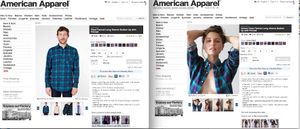
Hypersexualization is the sexualization and objectification of a person. This is a basic definition of the concept. In marketing, this hypersexualization is most often applied to women and girls (girls being defined as children). The hypersexualization usually take the form of ads with scantily clad women. These ads aim for a target market of heterosexual men. When compared to advertisements featuring men, the sexualization of women’s bodies is evident.
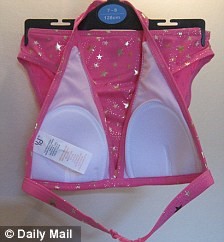
Hypersexualization in marketing does not only take the form of advertising, but of products as well. This is most noticeable in children’s products. The Canadian Women’s Health Network (CWHN) defines the hypersexualization of girls as being “depicted or treated as sexual objects. It [is] sexuality that is inappropriately imposed on girls through media, marketing or products directed at them that encourages them to act in adult sexual ways”.[12] Sexual products directed at young children range anywhere from thongs to padded bikinis/bras. Companies such as Primark and Ambercrombie and Fitch have recently been called out for the sexualization of children through their padded and pushup bikini lines for children as young as seven.[11]
Intersectionality
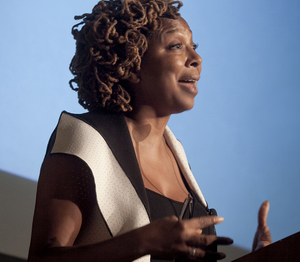
Intersectionality is a term coined by Kimberle Crenshaw in her article “Demarginalizing the intersection of race and sex: A black feminist critique of antidiscrimination doctrine, feminist theory and antiracist politics”.[14] In Leslie McCall’s article “The Complexity of Intersectionality”, intersectionality is defined as “the relationships among multiple dimensions and modalities of social relations and subject formations”.[15] Essentially, this means that one’s traits cannot be treated as mutually exclusive. As Crenshaw puts it, traits such as race and gender cannot be treated “as mutually exclusive categories of experience and analysis”, but instead must be examined in tandem with one another.[14] This theory can include the intersection of all manner of traits. To list only a few examples: health, race, gender, sex, and economic status. This term would apply, for example, when examining the feminism as applied to an Asian woman, versus a Caucasian woman.
When applied to marketing, the intersection of race and gender is of particular relevance. In North American marketing, one often sees the hypersexualization and “exoticist fascination” of women of colour.[16] Throughout media and marketing ads, women of colour are often treated as pornographic objects, being highly sexualized and depicted as animalistic.[17] In contrast, Caucasian people are “regarded as much more capable of controlling their instincts than other races”.[18] This, as a result, has lead to the fetishization of Black and Asian women in particular. Companies capitalize on this system that they have both created and preserved, using it particularly towards a target market consisting of heterosexual men.
Gendered Marketing
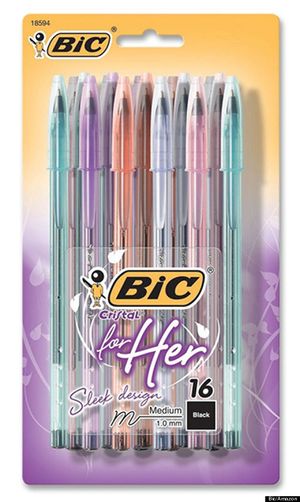
Gendered marketing is the adaptation of products to target a specific gender. Often this will mean the selling of the same product, but adapted slightly to sell to an audience of both men and women, creating a bigger target market and more sales for the company. A highly used example of gendered marketing is in the selling of deodorant. They are always sectioned off into a male and female display, with the men’s products often being less expensive. There is, however, no real point other than larger sales to divide them. Deodorant is deodorant. It serves the same purpose, no matter what one’s gender.
Starting With the Children
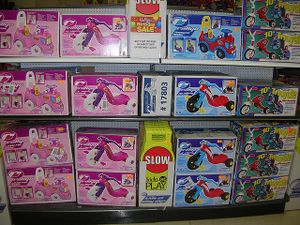
Gendered marketing starts the moment one is born. There are the pink clothes for the girls, and the blue for the boys. The toys they’re meant to play with, based on binary assignation of the child’s gender, are separated in stores. A basic example of this is girls being expected to play with dolls, boys with action figures. The gendering of children’s toys persists because “many aspects of adults’ expectations for children are gendered, including adults’ perceptions of the toys that are appropriate for boys and appropriate for girls”.[21] Adults, the ones already programmed to define toys by gender, are the ones with the income to purchase these toys for the children. By insisting the children play with gendered toys, the adults are only assisting companies with this marketing scheme. Starting this gendered marketing so young, allows companies to mold impressionable children to continue conforming and buying gendered products as they age.
Breast Cancer
In the late 1970s. a widespread feminist concern for breast cancer had started gaining momentum as First Lady Betty Ford had made her diagnosis public. Prior to her announcement, the subject of breast cancer was a taboo subject, which was likely due to “the conjuncture of ‘breast’ that seemed to spook the public”. By the late 1980s, feminist messages have gained public recognition through pop culture, and thus challenged the portrayal of women in society. As the mastectomy images of former model Matuschka became widespread throughout mainstream media, “breast cancer” soon became a means to strengthen consumer hold on women; leading to the commodification of breast cancer and to the outbreak of mass delusion regarding the disease as it seeks to downplay mortality and promote “obedience to medical protocols known to have limited efficacy”. This is further seen through the infantilizing theme of teddy bears and crayons that subtly encourages women to retrieve to a regressive state which suggests the inability for a woman to make an independent decision interpretation[22].
References
- ↑ Leneck, C. M. "Definition of gender", Canadian Medical Association Journal. U.S. National Library of Medicine, 15 Jan. 1994..
- ↑ "Resolutions Adopted by General Council", Canadian Medical Association, 20 Aug. 2014.
- ↑ "Definition of Cisgender in English", Oxford Dictionaries.
- ↑ Market Segmentation
- ↑ "Target Market Definition", Investopedia, 21 Jan. 2010.
- ↑ Malär, Lucia, et al. "Emotional Brand Attachment and Brand Personality: The Relative Importance of the Actual and the Ideal Self", Journal Of Marketing 75.4 (2011): 35-52. Communication & Mass Media Complete.
- ↑ Hollister Advertisement
- ↑ Jump up to: 8.0 8.1 Groesz, Lisa M., Michael P. Levine, and Sarah K. Murnen. "The Effect of Experimental Presentation of Thin Media Images on Body Satisfaction: A meta‐analytic Review", International Journal of Eating Disorders 31.1 (2002): 1-16.
- ↑ Mazda Week Advertisement
- ↑ American Apparel Advertisements
- ↑ Jump up to: 11.0 11.1 Poulter, Sean. "Primark Shamed into Axing Padded Bikinis for Girls of 7 after Being Accused of 'disgraceful' Sexualisation of Children.", Mail Online. Daily Mail, 14 Apr. 2010. Cite error: Invalid
<ref>tag; name "http://www.dailymail.co.uk/news/article-1265873/Primark-withdraws-padded-bikinis-7-year-olds.html" defined multiple times with different content - ↑ "Hypersexualization of young girls: Why should we care?", Canadian Women's Health Network.
- ↑ Kimberle Crenshaw
- ↑ Jump up to: 14.0 14.1 Crenshaw, Kimberle. "Demarginalizing the intersection of race and sex: A black feminist critique of antidiscrimination doctrine, feminist theory and antiracist politics", University of Chicago Legal Forum (1989): 139-167.
- ↑ McCall, Leslie. "The Complexity of Intersectionality", Signs 30.3 (2005): 1771–1800.
- ↑ Neptune, Harvey R. "Caliban and the Yankees", Chapel Hill, US: The University of North Carolina Press, 2007. ProQuest ebrary.
- ↑ Hill Collins, Patricia. "Black Feminist Thought: Knowledge, Consciousness, and the Politics of Empowerment", New York: Routledge, 2009;1999;
- ↑ Valverde, Mariana. "The Age of Light, Soap, and Water: Moral Reform in English Canada, 1885-1925". Toronto: McClelland & Stewart, 1991.
- ↑ Bic's Pen for Her
- ↑ Gendered Children's Toys
- ↑ Auster, Carol J., and Claire S. Mansbach."The Gender Marketing of Toys: An Analysis of Color and Type of Toy on the Disney Store Website", Sex Roles 67.7 (2012): 375-88.
- ↑ [1]. Ehrenreich. B.,Welcome to Cancerland: A Mammogram Leads to a Cult of Pink Kitsch